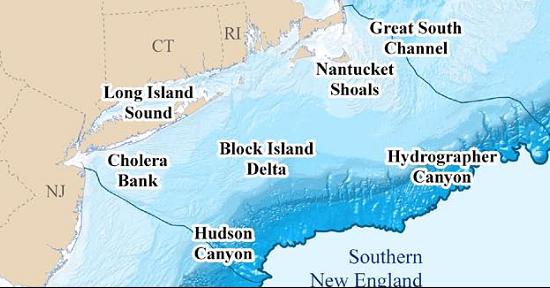Southern New England waters
Map of Southern New England waters. Credit: NOAA
The Southern New England eco-region extends from the Great South Channel in the north to Hudson Canyon in the south, and from the coasts for Cape Cod, Rhode Island, and Connecticut to the continental shelf break (1). It includes a string of landforms created by glacial moraines: Long Island Sound, Block Island, Matha’s Vineyard, and Nantucket.
The diverse array of habitats found within the Southern New England marine region, and its position between cold-water and warm-water eco-regions, make it home to an exceptionally diverse array of fish species. The broad continental slope makes it a pathway for migratory species, including large pelagic fish, while the submarine canyons accommodate deep-water fish, and the estuarine areas dotting the coast sustain shallow-water fish and invertebrates. Historically, the region’s rivers supported large shad, eel, and salmon runs (3).
Most of the fish occurring in Southern New England waters are migrants: they move in a south or offshore in winter, and north or inshore with summer. About 15% of the fish species that use this ecosystem are northern and 75% are southern, causing some observers to group it withthe Mid-Atlantic Bight (2). Many southern species migrate here only in summer. Other species move inshore and offshore with the seasons. Cape Cod is considered a strong migration barrier and many of the inshore species in the Gulf of Maine do not appear in Southern New England, and vice-versa.
The region's mixing-bowl characteristics mean that it will be one of the first areas to see the impacts of climate change. Northern species present in this ecosystem, such as Atlantic cod and American lobster, are moving northward and out of this ecosystem, while southern species like croaker and blue crab, are expected to extend their range and become more prolific in this ecosystem. Climate change in Southern New England waters is causing a "reshuffling of the deck" in terms of the area's food webs.
Studies of Narragansett Bay and Rhode Island Sound show significant shifts in this eco-region's ecological community over the last half-century (4). Once dominanted by finfish, the area is now dominated by invertebrates such as crab and squid. Once home to many demersal (bottom-dwelling) species, it is now characterized by an abundance of pelagics (species that dwell in the water column. The average size of fish has gotten smaller, and there has been a rise in seasonal warm-water fish like scup, butterfish, and squid. All of these change indicate a fundamental change has taken place in this eco-region, perhaps driven by water temperature, which increased 1.6 degrees during the late 20th century (4).
Sources:
1. Cook and Auster 2007
2. Sherman et al 1996, cited in Cook and Auster
3. Green et al 2010

